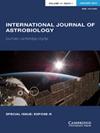关于地球以外可能的生命扩散模式
IF 1
4区 物理与天体物理
Q3 ASTRONOMY & ASTROPHYSICS
引用次数: 0
摘要
系外行星与其周围环境“处于平衡”的假设并没有让位于大空间尺度上的生命透过率。另一方面,人类疾病的传播和我们星球上大规模灭绝后的生命恢复速度可能表现出空间和时间尺度以及分布相关性,从而影响其特征的可绘制范围。我们利用随机感染动力学过程在单个银河系区域内模拟假设的生物扩散,这是受到地球上生命扩散的这些局部特性的启发。我们根据宜居性将恒星系统分成不同的类别,并使用类似于该模型的概率元胞自动机规则随着时间的推移对它们进行演化。作为一种动态效应,我们以一种避免对其代理(即存在问题)的假设的方式包括自然扩散向量(例如尘埃,小行星)的存在。此外,通过假设传播向量具有有限的速度和范围,该模型包含了“生命传播的光学深度”参数。振荡感染率($b(t,\;\, d)$)也考虑了扩散通量的长期行为,它在其进程中增加了扩散分量。寿命回收率($g(t,\;\, d)$)只是作为与大型动物多样性数据的链接而包含在模型中,这些数据表明,所有大灭绝在多样性恢复方面都有10兆元的“速度”。这个参数考虑了空的可行生态位的重新繁殖以及新生态位的形成,不排除在银河系中其他可居住的星球上真正的生命重新出现的可能性,这些星球已经被大规模的灭绝灭绝了。因此,银河系斑块内的所有生命传输事件都被映射到以参数$b$和$g$为特征的相空间中。我们发现相空间被分为持久传输、快速终止传输和两者之间的过渡区域。我们观察到,根据振荡生命传播速率的振幅,银河系斑块中的生命传播可能呈现不同的几何形状(即“波”)。即使一些寄主系统是无人居住的,生命传播也有一定的阈值,允许一个补丁在很长一段时间内充满可存活的物质。虽然可居住系统的局部密度的随机波动允许集群可以不断地相互感染,但当生命传播低于观察到的阈值时,空间格局就消失了,因此传播过程在时间上不是永久的。这两项发现都表明,在人口稠密地区的宜居行星可能不会受到感染。本文章由计算机程序翻译,如有差异,请以英文原文为准。
On possible life-dispersal patterns beyond the Earth
The assumption that exoplanets are ‘in equilibrium’ with their surroundings has not given way to life's transmissivity on large spatial scales. The spread of human diseases and the life recovery rate after mass extinctions on our planet, on the other hand, may exhibit spatial and temporal scaling as well as distribution correlations that influence the mappable range of their characteristics. We model hypothetical bio-dispersal within a single Galactic region using the stochastic infection dynamics process, which is inspired by these local properties of life dispersal on Earth. We split the population of stellar systems into different categories regarding habitability and evolved them through time using probabilistic cellular automata rules analogous to the model. As a dynamic effect, we include the existence of natural dispersal vectors (e.g. dust, asteroids) in a way that avoids assumptions about their agency (i.e. questions of existence). Moreover, by assuming that dispersal vectors have a finite velocity and range, the model includes the parameter of ‘optical depth of life spreading’. The effect of the oscillatory infection rate (
$b( t,\; \, d)$
) on the long-term behaviour of the dispersal flux, which adds a diffusive component to its progression, is also taken into account. The life recovery rate (
$g( t,\; \, d)$
) was only included in the model as a link to macrofaunal diversity data, which shows that all mass extinctions have a 10 Myr ‘speed rate’ in diversity recovery. This parameter accounts for the repopulation of empty viable niches as well as the formation of new ones, without ruling out the possibility of genuine life reemergence on other habitable worlds in the Galaxy that colossal extinctions have sterilized. All life-transmission events within the Galactic patch have thus been mapped into phase space characterized by parameters
$b$
and
$g$
. We found that phase space is separated into subregions of long-lasting transmission, rapidly terminated transmission, and a transition region between the two. We observed that depending on the amplitude of the oscillatory life-spreading rate, life-transmission in the Galactic patch might take on different geometrical shapes (i.e. ‘waves’). Even if some host systems are uninhabited, life transmission has a certain threshold, allowing a patch to be saturated with viable material over a long period. Although stochastic fluctuations in the local density of habitable systems allow for clusters that can continuously infect one another, the spatial pattern disappears when life transmission is below the observed threshold, so that transmission process is not permanent in time. Both findings suggest that a habitable planet in a densely populated region may remain uninfected.
求助全文
通过发布文献求助,成功后即可免费获取论文全文。
去求助
来源期刊

International Journal of Astrobiology
地学天文-地球科学综合
CiteScore
3.70
自引率
11.80%
发文量
45
审稿时长
>12 weeks
期刊介绍:
International Journal of Astrobiology is the peer-reviewed forum for practitioners in this exciting interdisciplinary field. Coverage includes cosmic prebiotic chemistry, planetary evolution, the search for planetary systems and habitable zones, extremophile biology and experimental simulation of extraterrestrial environments, Mars as an abode of life, life detection in our solar system and beyond, the search for extraterrestrial intelligence, the history of the science of astrobiology, as well as societal and educational aspects of astrobiology. Occasionally an issue of the journal is devoted to the keynote plenary research papers from an international meeting. A notable feature of the journal is the global distribution of its authors.
 求助内容:
求助内容: 应助结果提醒方式:
应助结果提醒方式:


